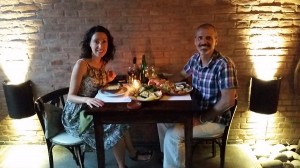 Quasi una tappa d'obbligo per passare in Cile, direzione Santiago.
In realta' era sulla nostra lista sin dall'inizio visto che e' la zona dell'Argentina famosa per la produzione vinicola, soprattutto del Malbec: Mendoza e' la Toscana argentina ma molto molto piu calda.
Primo giorno come di rito ce la dormiamo dopo aver viaggiato di notte con il bus e ci premiamo con una super cena in un risorantino niente male suggerito da altri viaggiatori (Anna Bistro, se qualcuno capitasse da quelle parti merita!)
Secondo giorno inizia la passaggiata di perlustrazione della citta' con raccolta di info per eventuali escursioni. La citta' e' facile da capire e da camminare: strade ampie e piazze spaziose sono il risultato di una ricostruzione urbana avvenuta dopo il terremoto del 1861 che livello' la citta' al suolo. I mendocini in previsione di un prossimo terremoto hanno voluto prevenire e creare aree di sicurezza e affollamento – non si sa mai!
Quasi una tappa d'obbligo per passare in Cile, direzione Santiago.
In realta' era sulla nostra lista sin dall'inizio visto che e' la zona dell'Argentina famosa per la produzione vinicola, soprattutto del Malbec: Mendoza e' la Toscana argentina ma molto molto piu calda.
Primo giorno come di rito ce la dormiamo dopo aver viaggiato di notte con il bus e ci premiamo con una super cena in un risorantino niente male suggerito da altri viaggiatori (Anna Bistro, se qualcuno capitasse da quelle parti merita!)
Secondo giorno inizia la passaggiata di perlustrazione della citta' con raccolta di info per eventuali escursioni. La citta' e' facile da capire e da camminare: strade ampie e piazze spaziose sono il risultato di una ricostruzione urbana avvenuta dopo il terremoto del 1861 che livello' la citta' al suolo. I mendocini in previsione di un prossimo terremoto hanno voluto prevenire e creare aree di sicurezza e affollamento – non si sa mai!
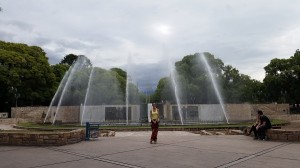 Abbiamo avuto la sensazione che abbiano ricostruito le strade a tema: il centro e' pedonale, intorno al centro ci sono vie adibite al commercio e agenzie di viaggi; poi si trovano sparsi per la citta' piccoli centri residenziali con villette e villone; mentre tutta la vita notturna in Avenida Aristides strada vicino il centro affollata e piena di locali per mangiare, bere, ballare; li ci sono anche ostelli ma non credo si dorma molto.
Nel nostro pellegrinare senza meta decidiamo cosa fare nei giorni successivi: passeggiata ad Aconcagua e Puente del Inca, stazione termale di Cacheuta e ovviamente visita con degustazione a vigneti e bodegas circostanti.
Abbiamo avuto la sensazione che abbiano ricostruito le strade a tema: il centro e' pedonale, intorno al centro ci sono vie adibite al commercio e agenzie di viaggi; poi si trovano sparsi per la citta' piccoli centri residenziali con villette e villone; mentre tutta la vita notturna in Avenida Aristides strada vicino il centro affollata e piena di locali per mangiare, bere, ballare; li ci sono anche ostelli ma non credo si dorma molto.
Nel nostro pellegrinare senza meta decidiamo cosa fare nei giorni successivi: passeggiata ad Aconcagua e Puente del Inca, stazione termale di Cacheuta e ovviamente visita con degustazione a vigneti e bodegas circostanti.
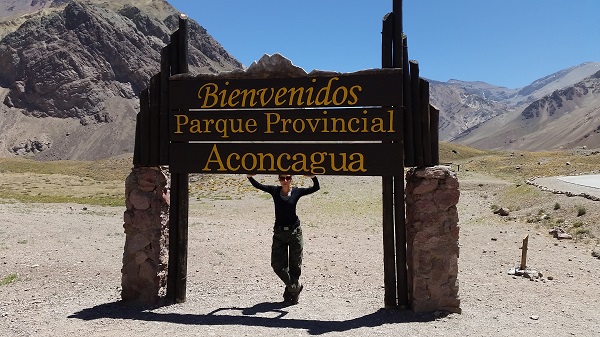 Aconcagua e' la montagna piu alta del Sud America circa 6.900 metri di altezza, a confine tra Argentina e Chile, e in lingua Quequa significa 'sentinella di pietra'. La montagna e' suggestiva e colorata: il bianco della neve sul picco e tutto intorno la Cordigliera con dei colori incredibili dati dalla presenza di diversi elementi rocciosi (granito, rame, ferro). E' stato bello salire dalla citta' e passare dalle pre-cordigliera a 2000m a la cordigliera delle Ande (si puo' arrivare fino ai 6.000 metri ed oltre dell'Aconcuaga), ripercorrendo parte della famosa Ruta 40 che taglia l'Argentina dalla Patagonia fino su in Bolivia. La salita e' stata graduale facendo diverse tappe: prima ad una diga chiamata Los Potrerillos, poi alla cittadina di Upsallata, che ha accolto Brad Pitt durante le riprese di sette anni in tibet girato su Aconcagua (Info turistica fondamentale!), il centro sciistico Los Penitentes ovviamente chiuso ma con la seggiovia in funzione per chi come Pietro malinconico sente la necessita' di salire sulla montagna anche senza neve.. e Puente del Inca, che fa da anticapera alla montagna.
Aconcagua e' la montagna piu alta del Sud America circa 6.900 metri di altezza, a confine tra Argentina e Chile, e in lingua Quequa significa 'sentinella di pietra'. La montagna e' suggestiva e colorata: il bianco della neve sul picco e tutto intorno la Cordigliera con dei colori incredibili dati dalla presenza di diversi elementi rocciosi (granito, rame, ferro). E' stato bello salire dalla citta' e passare dalle pre-cordigliera a 2000m a la cordigliera delle Ande (si puo' arrivare fino ai 6.000 metri ed oltre dell'Aconcuaga), ripercorrendo parte della famosa Ruta 40 che taglia l'Argentina dalla Patagonia fino su in Bolivia. La salita e' stata graduale facendo diverse tappe: prima ad una diga chiamata Los Potrerillos, poi alla cittadina di Upsallata, che ha accolto Brad Pitt durante le riprese di sette anni in tibet girato su Aconcagua (Info turistica fondamentale!), il centro sciistico Los Penitentes ovviamente chiuso ma con la seggiovia in funzione per chi come Pietro malinconico sente la necessita' di salire sulla montagna anche senza neve.. e Puente del Inca, che fa da anticapera alla montagna.
 Il Ponte degli Inca e' un'altra area dichiarata dall'UNESCO Patrimonio Mondiale dell'Umanita', e' una sorgente di acqua sulfurea calda naturale conosciuta dalla popolazione Inca che abitava qui tra Argentina e Cile, prima di essere massacrati dagli spagnoli. Oggi l'area e' chiusa al pubblico, precisamente dal 2005, ma prima era una stazione termale molto conosciuta, c'era anche un albergo a pochi metri disrutto da una frana. Il ponte offre uno spettacolo naturale molto suggestivo, che attrasse Charles Darwin che inizio' degli studi geologici su questa terra nel 1835. E' naturalmente pitturato di rosso, giallo e arancione, e si presenta con una cornice grigia giallastra della Cordigliera coperta di 'coiron', una pianta gialla che cresce in queste zone semi desertiche.
La nostra passeggiata prevedeva la salita a 4.200 metri dove hanno posto il Cristo Redentor, una mini copia simile a quella di Rio, dove c'e' una vista mozzafiato... dicono. Noi non lo sappiamo, non ci siamo potuti andare: il bus ha bucato la gomma per ben due volte e con una ruota in meno non era sicuro salire, con grande dispiacere di Pietro. Ci siamo consolati al rifugio con un bel paninazzo casereccio e bello imbottito.
Il Ponte degli Inca e' un'altra area dichiarata dall'UNESCO Patrimonio Mondiale dell'Umanita', e' una sorgente di acqua sulfurea calda naturale conosciuta dalla popolazione Inca che abitava qui tra Argentina e Cile, prima di essere massacrati dagli spagnoli. Oggi l'area e' chiusa al pubblico, precisamente dal 2005, ma prima era una stazione termale molto conosciuta, c'era anche un albergo a pochi metri disrutto da una frana. Il ponte offre uno spettacolo naturale molto suggestivo, che attrasse Charles Darwin che inizio' degli studi geologici su questa terra nel 1835. E' naturalmente pitturato di rosso, giallo e arancione, e si presenta con una cornice grigia giallastra della Cordigliera coperta di 'coiron', una pianta gialla che cresce in queste zone semi desertiche.
La nostra passeggiata prevedeva la salita a 4.200 metri dove hanno posto il Cristo Redentor, una mini copia simile a quella di Rio, dove c'e' una vista mozzafiato... dicono. Noi non lo sappiamo, non ci siamo potuti andare: il bus ha bucato la gomma per ben due volte e con una ruota in meno non era sicuro salire, con grande dispiacere di Pietro. Ci siamo consolati al rifugio con un bel paninazzo casereccio e bello imbottito.
Mendoza - 1 episode Almost a must to go to Chile, to Santiago. In reality it was on our list since the beginning, as this is the famous area of Argentina for the wine production, especially for the Malbec: Mendoza is like the Argentinean Hunter Valley but a touch more hot and dry.
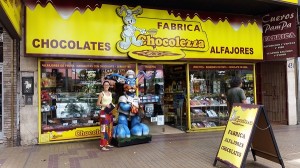 First day as per usual we slept after having traveled by night in a bus and then we rewarded ourselves with a great dinner in a little restaurant that was suggested by other travelers (Anna Bistro, in case someone is going there!)
Second day the searching walk started with collection of info for excursions. The city is easy to understand and to walk around: broad streets and big squares are the result of an urban reconstruction after the earthquake of 1861, which leveled the city to the ground. The Mendocinos
in anticipation of an upcoming earthquake wanted to prevent and create safe areas – just in case!
We had the feeling that they have rebuilt the roads following themes: the center is pedestrian, around the center there are streets for shopping and travel agencies; then scattered around the city, there are small residential centers with terrace house and villas; while all the night-life is on Avenida Aristides, a really crowded street, full of places where to eat, drink, dance. There are also hostels but I do not think you can sleep a lot.
In our aimless pilgrimage, we decided what to do in the following days: Aconcagua mountain and Puente del Inca walk, Cacheuta hot springs and of
course a visit with wine tasting to the surrounding vineyards and bodegas.
First day as per usual we slept after having traveled by night in a bus and then we rewarded ourselves with a great dinner in a little restaurant that was suggested by other travelers (Anna Bistro, in case someone is going there!)
Second day the searching walk started with collection of info for excursions. The city is easy to understand and to walk around: broad streets and big squares are the result of an urban reconstruction after the earthquake of 1861, which leveled the city to the ground. The Mendocinos
in anticipation of an upcoming earthquake wanted to prevent and create safe areas – just in case!
We had the feeling that they have rebuilt the roads following themes: the center is pedestrian, around the center there are streets for shopping and travel agencies; then scattered around the city, there are small residential centers with terrace house and villas; while all the night-life is on Avenida Aristides, a really crowded street, full of places where to eat, drink, dance. There are also hostels but I do not think you can sleep a lot.
In our aimless pilgrimage, we decided what to do in the following days: Aconcagua mountain and Puente del Inca walk, Cacheuta hot springs and of
course a visit with wine tasting to the surrounding vineyards and bodegas.
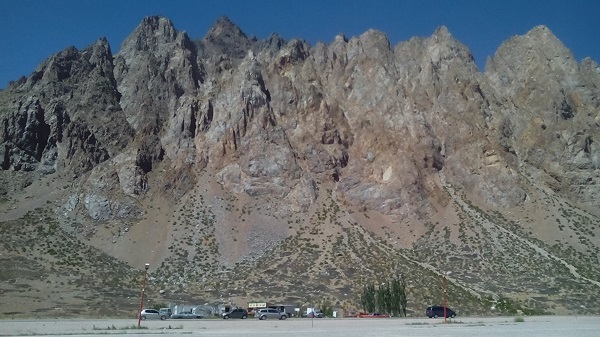 Aconcagua is' the highest mountain in South America about 6,900 feet high, placed on the border between Argentina and Chile, and in language Quequa means 'sentinel stone'. The mountain is evocative and colourful: the white snow on the peak and all around the Cordillera there are incredible colours given by the presence of different elements and rocks (granite, copper, iron). It's been great to go up from the city and pass the pre-cordillera at 2000m in the Andes (you can get up to 6,000 meters and beyond of the Aconcuaga), retracing part of the famous Route 40 that cuts Argentina from Patagonia up to Bolivia.
Aconcagua is' the highest mountain in South America about 6,900 feet high, placed on the border between Argentina and Chile, and in language Quequa means 'sentinel stone'. The mountain is evocative and colourful: the white snow on the peak and all around the Cordillera there are incredible colours given by the presence of different elements and rocks (granite, copper, iron). It's been great to go up from the city and pass the pre-cordillera at 2000m in the Andes (you can get up to 6,000 meters and beyond of the Aconcuaga), retracing part of the famous Route 40 that cuts Argentina from Patagonia up to Bolivia.
 The climbing was gradually making several stages: first, a dam called Los Potrerillos, then the town of Upsallata, who welcomed Brad Pitt during the shooting of Seven years in Tibet shot on Aconcagua (Essential tourist info!); then the ski center Los Penitentes obviously closed, but with the chair lift in operation for people like Pietro who melancholic feels the need to climb the mountain without snow.. and Puente del Inca, which is the antechamber to the mountain.
The climbing was gradually making several stages: first, a dam called Los Potrerillos, then the town of Upsallata, who welcomed Brad Pitt during the shooting of Seven years in Tibet shot on Aconcagua (Essential tourist info!); then the ski center Los Penitentes obviously closed, but with the chair lift in operation for people like Pietro who melancholic feels the need to climb the mountain without snow.. and Puente del Inca, which is the antechamber to the mountain.
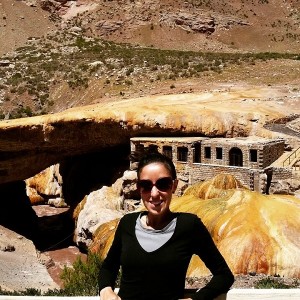 The Bridge of the Incas is' another area declared by UNESCO a World Heritage, it is a source of natural hot sulphur water known by the Inca, the people who lived between Argentina and Chile - before being massacred by the Spaniards. Today the area is closed to the public, precisely since 2005, but before it was a well-known spa, there was also a hotel but it was destroyed by a landslide. The bridge offers a natural spectacle, which attracted Charles Darwin that begun his geological studies on this land in 1835. The bridge is naturally painted in red, yellow and orange, and it framed by the grey-yellow Cordillera: the mountains are covered by 'coiron', a yellow plant that grows in these semi-desert areas.
Our walk included the climbing to 4,200 meters, where they place the Cristo Redentor, a mini copy similar the one in Rio, where there is a breathtaking view ... they say. We do not know, we couldn't go: the bus blew a tire, twice, and with minus a wheel it was not safe to climb, with great displeasure if Pietro. We consoled at the shelter with a nice home-made nice filled panino.
The Bridge of the Incas is' another area declared by UNESCO a World Heritage, it is a source of natural hot sulphur water known by the Inca, the people who lived between Argentina and Chile - before being massacred by the Spaniards. Today the area is closed to the public, precisely since 2005, but before it was a well-known spa, there was also a hotel but it was destroyed by a landslide. The bridge offers a natural spectacle, which attracted Charles Darwin that begun his geological studies on this land in 1835. The bridge is naturally painted in red, yellow and orange, and it framed by the grey-yellow Cordillera: the mountains are covered by 'coiron', a yellow plant that grows in these semi-desert areas.
Our walk included the climbing to 4,200 meters, where they place the Cristo Redentor, a mini copy similar the one in Rio, where there is a breathtaking view ... they say. We do not know, we couldn't go: the bus blew a tire, twice, and with minus a wheel it was not safe to climb, with great displeasure if Pietro. We consoled at the shelter with a nice home-made nice filled panino. 